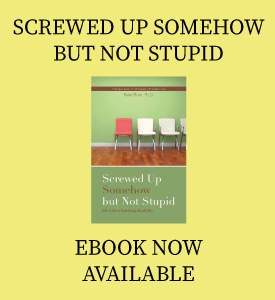In a recent post I discussed accommodations at work. Now, I’ll discuss the much larger topic of accommodations at school. Larger, at least, because more has been written about it. The National Center for Learning Disabilities (NCLD) has a whole page devoted to school accommodations; in fact, it’s more than one page because there are lots of links. I am not going to go over them all, rather, I want to discuss how NLD in particular plays in with the type of accommodation.
Because dyslexia is one of the most common and best known LDs, many accommodations are developed to help dyslexics. Similarly, the best known LD with regard to writing is dysgraphia. When it comes to math, there is dyscalculia.
NLDers may have problems with reading, but not usually with the act of decoding words and sentences. Rather, when we have trouble with reading (if we do at all) it’s usually with higher level things: Visualization, allusion, shifting character viewpoints and so on. I love to read and I read very omnivorously and at a pretty high level. But the one type of writing I have the most trouble with is “literature”. So, when we have trouble with reading we don’t need the sort of accommodations that dyslexic people find useful: It’s not about decoding words and phrases,it’s about understanding the same sort of nonverbal stuff that we have trouble with in other areas.
Similarly, with writing. Much software and accommodations devoted to writing assume that a graphical approach will help. This may help a lot of people with dysgraphia, but they are a nightmare for me. What I want is not something that turns text into graphics; I want something that turns graphics into text! Problems with writing can be divided into two groups: Penmanship and organization. For the former, the keyboard is a wonderful accommodation; a scribe might also be good. For the latter, I like outlining, sometimes very detailed outlining. And I also like LaTeX, which does take getting used to but which allows allows you to easily hide and then show different levels of your text.
For math: I never had problems. I don’t know good math accommodations. But if you know of some, that’s what comments are for!



I home school my daughter with NLD. We use a well respected math curricula but I still take the workbook problems and redo them on a plain white paper in large print. All the graphics that are included to make the workbook more engaging for children drive her crazy.
For a lot of kids with dyscalculia in the same sense my son has it, a calculator helps. Forty years ago, my brother, the LAWYER, was given a calculator in third grade and told to use it. He pays number people to count his money. So, knowing your math facts is not the be-all-end-all some teachers might think.
I suffer from Bipolar with a comorbid condition of ADD and mild Dyscalculia. I took some community college courses a little over a year ago and found that the community colleges really don’t invest in much resources to help people with such accommodations. It was like pulling teeth trying to get just the basic accomodations. I had a certified letter from my psychologist who suggested I use a basic calculator for tests and utilize visual graphs and the teachers and counselors all thought I was getting some kind of advantage over other students. The truth is even with these devices I still struggle with visual perception, numbers and number sequencing even with a basic calculator. There simply isn’t enough help for children or adults in schools and or colleges for these conditions.
Hi Cathy
I agree; accommodations tend to be even less available as we get older. However, many regular colleges do offer some services. E.g. Mitchell College in Connecticut. There are many others.
A math accommodation that worked wonders for my NVLD son in early elementary and still (now late elementary) with some types of math problems is large-square graph paper. Transferring all problems to 1-inch graph paper squares, preferably only one on a page, makes the numbers larger, more easily organized, and keeps columns and rows aligned properly, which can be hard for NVLD kids. Without the graph paper he’d do the math “right” but get the wrong answers because the columns were misaligned, or he’d get overwhelmed by many small numbers on a page stuffed with problems.